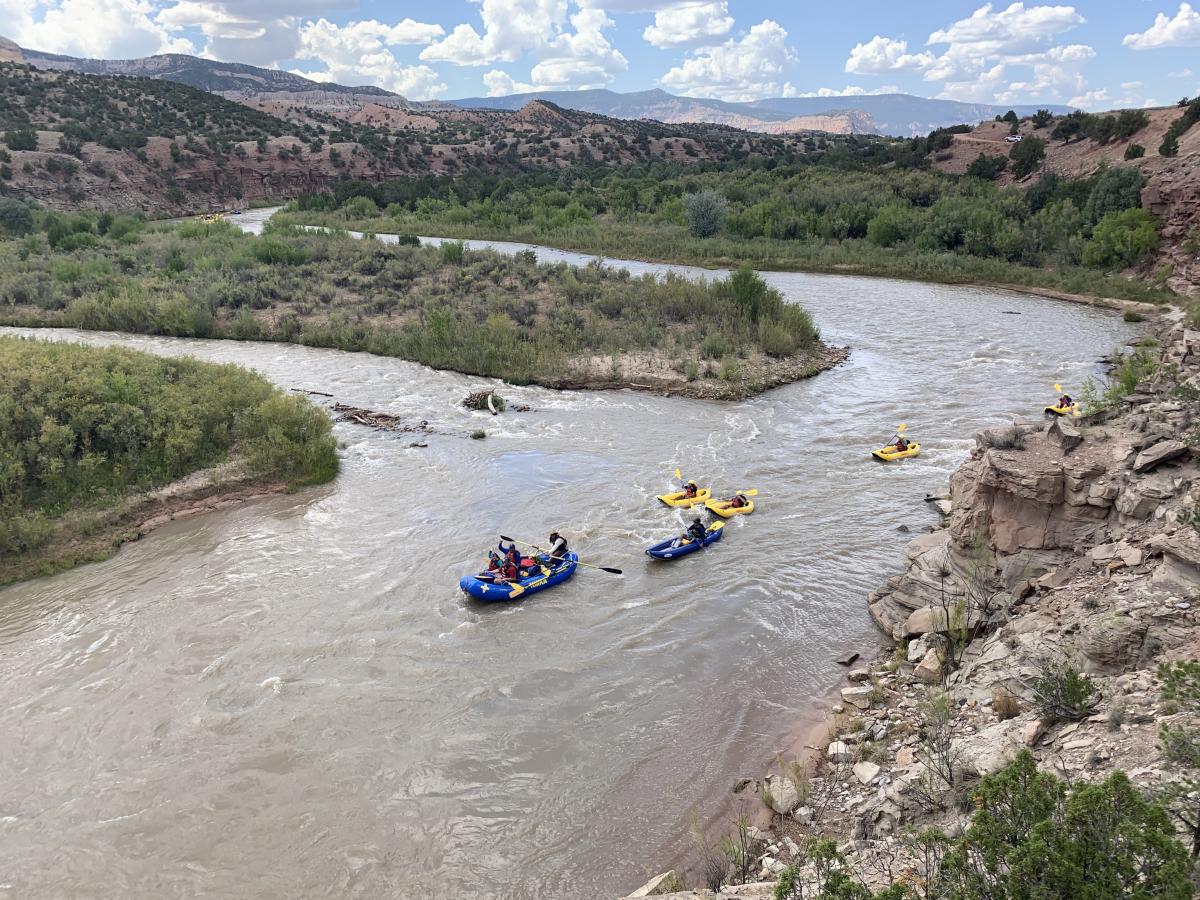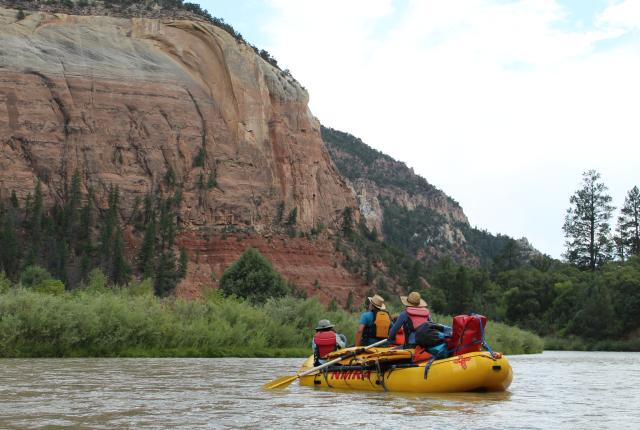The pace of the Río Chama offers plenty of opportunities to take in the surrounding landscape. Photograph courtesy of New Mexico River Adventures.
WHITEWATER CAN BE A FROTHY WORD, even in places with lots of big rivers. But in an arid state like New Mexico, a whitewater run on a hot summer day can feel like a face-to-face encounter with La Llorona—a pulse-raising, mouth-drying, full-body call to arms that’s equal parts trepidation and exhilaration, inspiring both fight and flight.
At least it was when I pushed off the bank of the Río Chama on the maiden river trip for both me and the one-person pack raft I had bought specifically for New Mexico summers. My rafting friends had said the river offered spectacular scenery, extraordinary geology, wildlife of all kinds, long stretches of tranquil floating—plus a few rapids. But as we left, my thoughts were focused on one thing: whitewater! I was terrified.
It didn’t help that within minutes of launching, the leader of our five-boat flotilla, a Santa Fean with decades of whitewater experience, got crosswise in a shallow riffle and flipped his canoe. He popped up dripping and sputtering, but laughing. My tensions eased just enough that when the current took hold of my boat, it felt as if school had let out for the year.
I grew up in Albuquerque’s North Valley, so water always seemed to be an integral part of summer. We splashed through sprinklers that made the July sun feel insignificant. We spent hours on the banks of the Río Grande, wetting our feet in the cool mud and ankle-deep flow. Swimming pools soon became the preferred hangout, and water pistols were our evening entertainment. When I eventually discovered boats and river trips, it was like a long sip from a cool fountain of youth.
New Mexico has only a handful of big, floatable rivers, but that scarcity makes each of them special. During summer, these waterways offer a unique combination of relief, relaxation, and restoration. At river level, the heat and complexity of modern life slip away.
Spending a couple of hours—or, better yet, a couple of days—dangling your hand in cold water as you meander downstream under a blue sky or feeling the shock of icy water rinse your face as you descend a rapid is pura vida.
The Río Chama may be the best place in New Mexico to catch the river bug. Starting as a trickle in the San Juan Mountains of southern Colorado, the Chama picks up tributaries and springs along the way, and eventually makes a 120-mile run to the Río Grande north of Española. Over time, the current has cut through 1,500 feet of sedimentary and volcanic rock laid down millennia ago, leaving behind multihued sandstone bluffs, steep cliff faces where peregrine falcons nest, wide, grassy beaches with shady piñon groves perfect for pitching a tent, and a conveniently located streamside hot spring. No wonder Congress designated 24.6 miles of the Río Chama—starting at Cooper’s El Vado Ranch—as a National Wild and Scenic River in 1988.
That stretch is the heart of the Río Chama float and a perfect summer outing for two or three days. It requires a Bureau of Land Management permit for much of the summer, but thanks to regular water releases from El Vado Reservoir, private and commercial trips are usually available from May through September.

With smooth floating and intermittent rapids, the Río Chama makes a great paddling adventure. Photograph courtesy of New Mexico River Adventures.
On my maiden voyage, we launched just below El Vado with enough food and gear to spend two nights. As we started downstream, I was pleased to discover that the Chama, like most rivers, features long stretches of calm water followed by brief interludes of excitement—the perfect rhythm for a lazy summer day. I didn’t have much time to enjoy the serenity, though. Less than two miles from the launch, we reached Eagle Bend, our first rapid. As I followed the lead boat through, my pulse got caught up in the flow, but most of the experience was a blur.
Everything happens so quickly. Concentration is key. Avoid the boulder on your left, push hard to get past another on the right, sneak between two more, and perhaps another dozen past them. Meanwhile, your boat bucks and waves explode off the bow, drenching your face but leaving you laughing. Then it’s over. Calm once again. Adrenaline lingers in your veins like the aroma of petrichor after a summer rain.
Time seemed to warp at this slower pace. The banks slipped by in stereoscope. Only a red-tailed hawk flying overhead with a snake in its talons broke the spell. At the end of the day, we rolled out sleeping bags under dark skies and relived the entire experience—again and again—around a campfire.
The next day, I faced down a stretch that included a half dozen rapids with names like Downpour, Dark Canyon, and Undercut. I had dreaded it for weeks. River runners classify whitewater by level of difficulty, Class I (flatwater, essentially) being the easiest and Class V for experts only. That class contains extremely long, often violent rapids, unavoidable waves, and whirlpools that can hold a boater underwater. Eagle Bend was Class II, and the biggest rapids on the river are Class III.
To my amazement, I remained upright through them all. Then someone mentioned a truism about boating that sticks with me still: “There are only two types of paddlers—those who have swum and those who will.” My day would come.
On our second night, we camped across from a 600-foot sandstone face where a pair of peregrine parents came and went with fresh food for their chicks. Over a small fire built in a steel pan to protect the beach, we enjoyed the simple pleasure of a warm meal after a day on the water. The exertion, the excitement, and the murmur of the stream gave us sweet dreams.
Our last day came with the river’s most challenging whitewater, but even those rapids were smaller than my imagination had conjured. The last few miles, past homesteads nestled among the cottonwoods and the majestic Monastery of Christ in the Desert, a few miles above Abiquiú Reservoir, slowed to a peaceful om as the river flattened out.
After hours or days of floating, pulling off any river is a letdown. But there is no mistaking the boost your spirit receives from the water you just left behind. Maybe that’s because the rules of the river are simple: You have no screens to check and you know where you’ll sleep. Now, when the summer sun rages or the afternoon traffic stacks up, I let my mind meander back to the cool kiss of a friendly wave.

EXPERT TIP: STAY HYDRATED
Even when you’re surrounded by water, it’s important to keep that Hydro Flask handy. “The Río Grande flows through a high-desert environment,” says Matt Gontram, owner and operator of New Mexico River Adventures. “Hydration will help make your day on the river the best by keeping your energy levels up, your balance on point, and your attitude spectacular.”
LAUNCH PATTERN
A permit is required to float the Upper Río Chama from April 15 to September 15. A lottery system is used for Friday and Saturday launches, while weekday permits are available through advance reservations on a first-come, first-served basis beginning April 1. Private launches outside the permit season are required to follow all regulations and do not require a permit. Call the BLM office in Taos with questions: 575-758-8851.
Several commercial operators run float trips from May into early October, depending on water levels:
Read More: Step into a kayak, canoe, or raft. Get hypnotized.


